Physical Address
304 North Cardinal St.
Dorchester Center, MA 02124
In recent years, surgeons have taken advantage of various technologies to aid in microvascular free flap reconstructions. In this chapter, we discuss the use of virtual surgical planning and rapid prototype modeling for use in craniofacial reconstructions with vascularized bone flaps, which helps the surgeon to plan an idealized reconstruction with respect to restoring the facial skeleton and streamlines the creation of osteotomies. Indocyanine green (ICG) angiography and computed tomography angiography (CTA) allow visualization of flap pedicle and perforator blood vessels, which can aid in flap design, among other useful applications in reconstructive surgery. Finally, surface 3-dimensional photography is useful not only for analyzing postoperative results in terms of quantifying volumetric changes, but it holds promise as a way of more accurately planning soft tissue surgery.
Advances in computer-assisted design (CAD) software have enabled surgeons to utilize 2-dimensional data, such as from a computed tomography (CT) scan, to generate a 3-dimensional virtual representation of a given body part. Such virtual body parts can be further manipulated, so that not only can surgical resections be rehearsed preoperatively, but various reconstructions with flaps, grafts, and implants can also be carried out on the computer to restore the missing parts in an idealized fashion ( Fig. 4.1 ). While the applications for computer simulation of reconstructive surgeries is limitless, such technologies have become most widely applied to bony reconstruction of mandibular, maxillary, and other craniofacial defects.
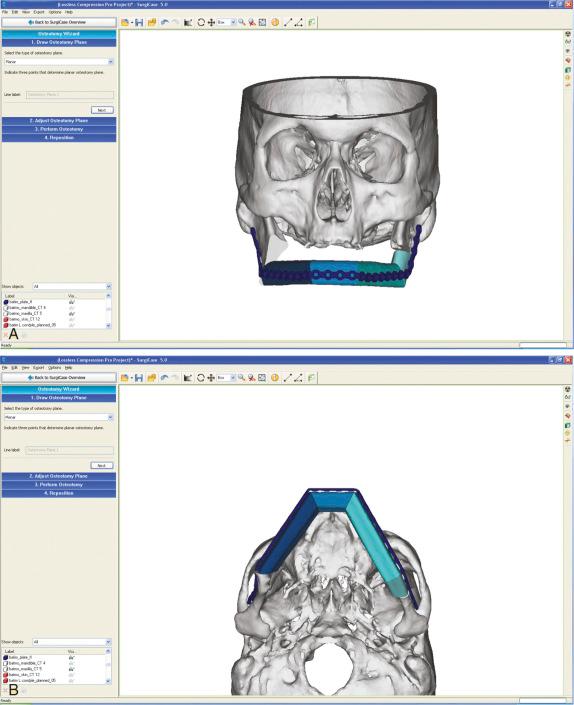
Concurrent with advances in software, the development of 3-dimensional printing allows the creation of physical models from CAD computer data that are not only helpful in allowing the surgeon to visualize the patient's actual anatomy but, more practically, can serve as a template for bending and shaping the hardware used for bone flap, graft, and implant fixation ( Fig. 4.2 ). Additionally, computer-generated slotted cutting guides can also be manufactured using the same 3-dimensional printing process to assist with making osteotomies at the precise angles and lengths needed to replicate the planned reconstruction. Three-dimensional printing typically involves laying down successive thin layers of material that are bound or hardened by glue, light, or heat until the desired object has been manufactured. Three-dimensional printing processes are available for polymers, ceramics, glass, and metals. Because the process does not involve molds or dyes, 3-dimensional printing is substantially faster and less expensive than conventional manufacturing processes. Three-dimensional printing is also known as additive manufacturing, to distinguish it from subtractive processes, such as milling items from a block of material.
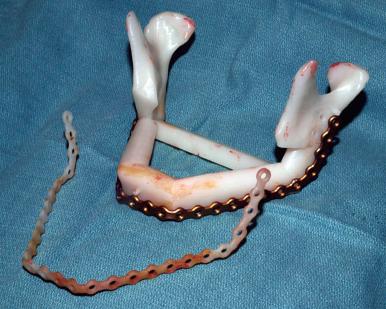
The term “stereolithography” specifically refers to the manufacture of 3-dimensional models using UV-light cured acrylic polymer resins. Stereolithography was the first additive manufacturing technique developed (in the 1980s) and has since spawned a multi-billion dollar industry for 3-dimensional printing. The process utilizes an ultraviolet laser to cure a photosensitive resin in sequential, thin, horizontally-oriented layers. The laser traces an area on the surface of a vat of liquid resin, curing only where it traces. The single layer, ranging of about 0.05–0.2 mm in thickness, is then hardened and “dipped” into the liquid vat to coat it with a new liquid layer. Subsequent scanning of the laser on the new layer both solidifies the new layer and adheres it to the layer below. Over the course of several hours, a 3-dimensional model is created. Post-processing is performed to remove excess liquid resin and fully cure the resultant parts. Stereolithographic models can be gas sterilized for use during surgery.
In a typical scenario, a fine cut (1–1.25 mm) axial head and neck CT scan with 0° of gantry tilt is obtained. The data is saved to a computer disk in a generic format (Digital Imaging and Communications in Medicine, DICOM), which can be utilized by CAD software to create a virtual 3-dimensional model of the facial skeleton that can be rotated in any direction. A CT scan of the bony free flap donor site is obtained, so that it can be manipulated using the software to create an idealized reconstruction. The fibula is usually used for bony free flap reconstruction in most practices, but virtually any site (e.g., scapula or iliac crest) can be imaged and imported into the CAD platform. If a donor site CT scan is not obtained, outcomes from using generic donor site data are usually acceptable.
The author, as well as others, have had success collaborating with computer engineers in third-party manufacturers rather than designing and printing our own models as we initially did. Virtual resection osteotomies of the mandible or maxilla in consultation with the resecting surgeon, if different from the reconstructive surgeon, are then planned. Next, the desired fibula, left or right, is selected and virtual osteotomies are performed as needed to reconstruct the missing mandible or maxilla. The original mandible or maxilla can be visualized as a partial transparency or “ghost” to help guide the shaping of the fibula reconstruction. When the existing mandible is misaligned due to displaced fracture or prior resection, the mandibular remnants can be repositioned. Occlusion is checked in multiple planes prior to finalizing the plan. If desired, a “double-barrel” fibula can be configured to correct for the height discrepancy between the fibula (mean of 17.9 mm in width on its lateral border in males) and the anterior mandible (mean of 33.5 mm in height at the symphysis in males).
Once the virtual plan is finalized, a model of the reconstructed mandible or maxilla is constructed using 3-dimensional printing technology. Slotted cutting guides are made for the maxilla or mandible that fit along the existing bony contours, as well as for the fibula or other free flap donor site ( Fig. 4.3 ). During surgery, the cutting guides are temporarily fixated to the mandible or maxilla and to the fibula with monocortical screws, and a reciprocating saw blade is inserted into the slots. Newer generation cutting guides feature metal inserts that snap into the slots, to minimize saw blade play and increase the accuracy of osteotomies. The models are sterilized and made available for use during surgery. Utilizing models to prebend titanium hardware prior to surgery can save operative time.
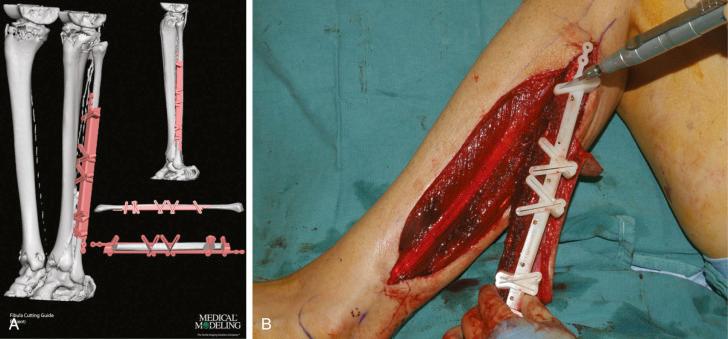
In our experience, use of virtual computer planning and 3-dimensional medical models with cutting guides saves operative time and increases reconstructive accuracy. Prebending hardware, as well as using the cutting guides to simplify osteotomies, saves operative time, particularly when multiple osteotomies are needed. The preoperative planning that occurs may also increase operative efficiency by improving surgical decision-making and reducing trial and error during fibular harvest and shaping, since the surgeon is forced to mentally rehearse the surgery ahead of time. We have shown increased accuracy compared with traditional methods of template bending along the native contours of the maxilla or mandible, and “eyeballing” the reconstruction when necessary, as well as a close correlation between the final reconstruction and the computer-assisted virtual plan. It has also been suggested that virtual planning and medical modeling makes bony head and neck reconstruction more accessible to less experienced and occasional osteocutaneous free flap surgeons. Even in experienced hands, however, computer planning and 3-dimensional models are beneficial for those cases in which the original architecture of the mandible or maxilla is not easily identifiable, including patients with exophytic tumors, displaced or comminuted pathologic fractures, and prior resections with and without prior reconstructions. In these patients, creating a template for shaping the reconstruction along the native contours of the mandible or maxilla is often difficult or impossible.
A negative of utilizing these technologies includes costs for engineering and manufacturing the models, which are arguably offset by operative time savings and increased accuracy. Virtual planning requires anywhere from 30 to 60 min, usually performed between the surgeon and a software engineer via web conference. Time is also needed to print and ship the models. While this usually only takes 1–2 days with express shipping, it makes the technique unfeasible when the initial consultation is performed just prior to surgery. Perhaps the greatest limitation is that the benefits of virtual planning and medical modeling are reduced when the operative plan changes, for example, due to tumor growth. To limit the potential for change in the resection and needed reconstruction, recent imaging is recommended, as is close communication between the resecting and reconstructive surgeons.
Rapid prototyping and computer-assisted design software continues to evolve. Such technologies are already commonly used by oral surgeons to guide endosteal implant placement in the native mandible and maxilla. Some have explored performing immediate implant placement at the time of free flap reconstruction, utilizing computer planning and custom drill guides to precisely place implants between hardware screws. Immediate implant placement takes advantage of the increased accuracy of bony reconstruction, since implants are rendered unusable if placed inaccurately at the wrong angulation. Another step that may substantially contribute to increased accuracy is the creation of patient-specific titanium hardware, which is not prebent, but rather milled from a solid block of titanium for maximal strength. Such patient-specific hardware allows the surgeon to select individual screw hole placement in the number, location, and angulation that is most optimal for a specific defect ( Fig. 4.4 ).
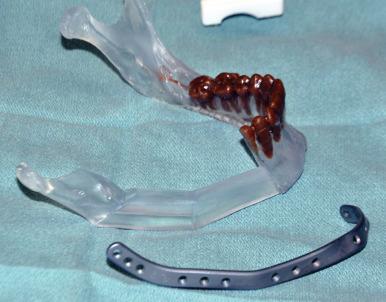
In addition to mandibular and maxillary reconstruction, virtual surgical planning and medical models has also been useful for orbital reconstruction. Very precise restoration of the orbital cavity is necessary to avoid enophthalmos, exophthalmos, or vertical dystopia (eyes at different heights). Bony free flaps can be designed for orbital reconstruction virtually, just as for the mandible and maxilla. More commonly in our practice, titanium mesh or bone grafts are used for orbital reconstruction and supported by soft tissue flaps. In these cases, we find that using a 3-dimensional model as a template for shaping bone grafts and mesh implants is easier than using the patient's actual orbit because surgical exposure is often limited, and retraction of the eye can result in injury to the globe, traction on the optic nerve, or bradycardia due to the oculocardiac reflex. Hardware or mesh is bent along the contours of a rapid prototype model ( Fig. 4.5 ), so that accurate restoration of the orbit is achieved. In cases where the original anatomy is distorted or absent, such as by tumor or trauma, a virtual template for reconstructing the bony contours of the orbit can be created by mirroring the unaffected side onto the affected side. Another more costly alternative is to create a patient-specific implant or plate that is produced by a third company that either mirrors the normal side or is created based on an orbit of an age matched control.
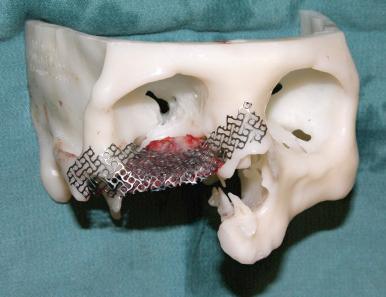
While use of bony free flap models combined with computer-generated cutting guides increases the accuracy of osteotomies and fixation of the flap segments to each other, accurate fixation to the remaining craniofacial skeleton is also necessary to restore facial shape and symmetry. Flap or graft insetting is particularly challenging in the midface and orbit when limited access incisions are used and surgical exposure is compromised. Inaccurate insetting, even by several millimeters, can result in malocclusion and inappropriate mid-facial projection or height in maxillary reconstruction, even when bony free flap osteotomies are perfectly executed. In orbital reconstruction, the tolerance for inaccuracy is even lower, with errors in fixation having not only aesthetic consequences but also potentially impaired vision or even blindness. In such cases, we, as well as others, have utilized intraoperative stereotactic navigation to confirm positioning of flaps and grafts in three dimensions.
Intraoperative navigation systems were initially developed for neurosurgical applications and were then adopted for use also in endoscopic sinus surgery. When utilizing navigation for virtually planned reconstructions, the virtual reconstruction images are back-converted to DICOM files and loaded into the central processing unit (CPU) of the navigation system along with the original CT data, so that both sets of images can be referenced during surgery. The most common computer navigation systems include InstaTrak (General Electric Healthcare, Buckinghamshire, UK); StealthStation (Medtronic-Xomed, Jacksonville, FL); Stryker Navigation System (Stryker-Leibinger, Kalamazoo, MI), and VectorVision (BrainLab, Westchester, IL). All of the systems utilize some type of sensor, either optical or electromagnetic, that is carried on a probe as well as fixed on the patient. Optical systems are utilized for reconstructive surgery, since electromagnetic systems require special instrumentation. Standard metallic instruments disrupt the electromagnetic field and result in tracking inaccuracies. The main disadvantage of optical systems is that a direct line of site must be maintained between the infrared-emitting diodes on the patient and probe, and the infrared sensors connected to the CPU.
Intraoperative navigation for reconstructive surgery is best performed using a rigidly fixed mobile array rather than a headset or frame, since the head must be able to turn freely during surgery. The infrared cameras are used to detect the patient's position based on reflectors connected to the mobile array, which is rigidly fixed to the calvarium at the start of surgery. The probe, essentially a wand with reflectors on it for localization with infrared light-emitting diodes, is used to confirm positioning by acting as a handheld pointer whose tip location is mirrored on the screen of the computer unit ( Fig. 4.6 ). Prior to use, a registration procedure in which the virtual patient on the computer workstation and the actual patient are overlapped by localization of at least three reference points with the probe. If the inset is not accurate, then it can be readjusted and positioning again checked against the virtual ideal.
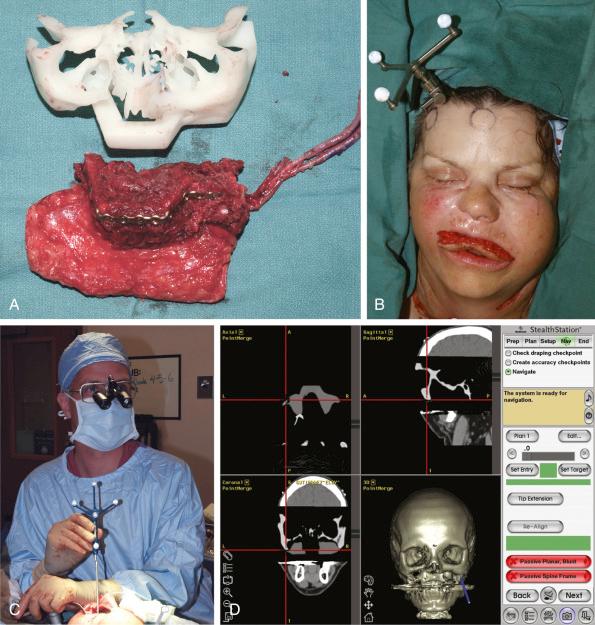
Become a Clinical Tree membership for Full access and enjoy Unlimited articles
If you are a member. Log in here